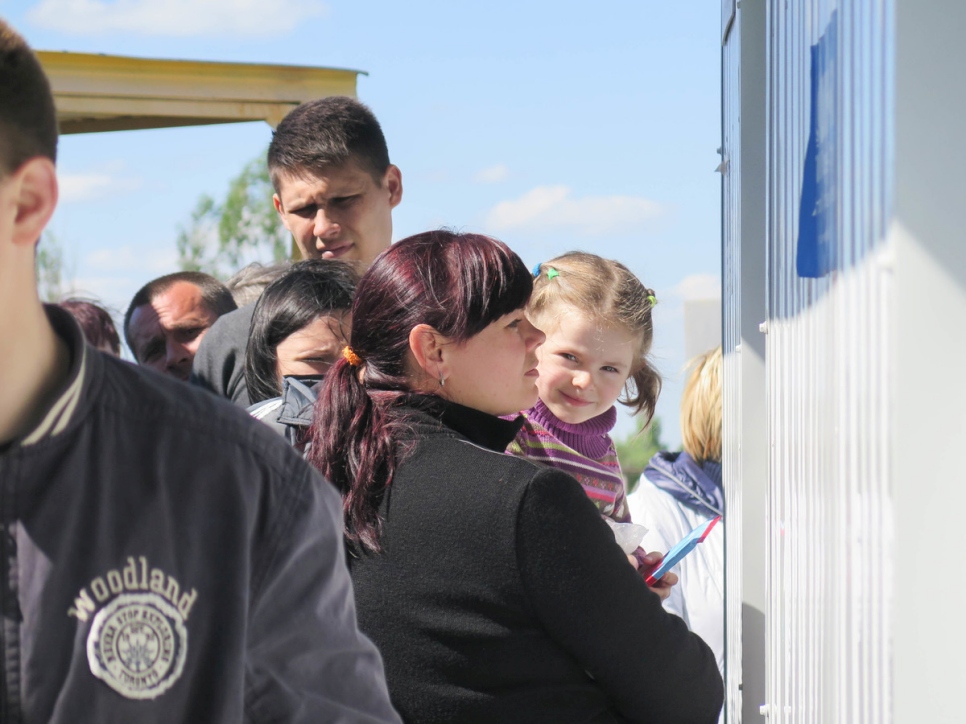
Two women approach a checkpoint and a sign warning of landmines in conflict-torn Donetsk.
© UNHCR/Tania Bulakh
As the devastating conflict in Ukraine enters its fourth year, crossing points between areas in the east of the country are tearing families apart.
The article was originally published at the UN Refugee Agency. By UDI Associate Tania Bulakh.
Valentina, 70, can barely walk with a stick. Her husband Gennadiy grasps her hand tightly to help, but he too has difficulties walking. Together, like thousands of other Ukrainians, they must cross a de facto border in the east of the country just to visit family, receive social payments and seek medical treatment.
Surrounded by minefields, crossing points are the only way to travel back and forth between conflict-torn areas in Eastern Ukraine. For many Ukrainians, this dangerous yet inevitable route is a part of their regular travel routine.
To get through a checkpoint, Valentina and Gennadiy must walk about 600 metres on foot from a bus stop and then wait in line for the necessary documents, before taking two buses to get to the checkpoint on the other side. A journey like this can be hard for anyone – but for vulnerable people with limited mobility it is excruciating. “This is inhuman,” says Valentina, wiping away her tears.
“We did not choose to live like this.”

Four-year-old Katya* and her mother regularly cross the checkpoint in the village of Marinka. © UNHCR/Tania Bulakh
The Ukrainian authorities have registered more than 6 million crossings of the contact line since the start of 2017, already fast approaching the overall 8.5 million crossings from 2016. One of the reasons for this increased mobility is the verification procedure for social payments that was introduced by the Ukrainian government. For many vulnerable people in non-government controlled territories these payments are vital for survival, leaving them with no choice but to travel back and forth.
“We did not choose to live like this,” says Viktoria*, who takes her four-year-old daughter, Katya*, across the dividing line once every two months to visit her sick grandfather. While Katya waits for a bus with her mother, the sound of gunfire echoes around the area, as fighting continues.
“This is inhuman.”
UNHCR, the UN Refugee Agency, is concerned about difficulties regarding freedom of movement of civilians, particularly while crossing the conflict line.
“There are frequently long queues and subsequent delays at checkpoints,” UNHCR spokesperson Andrej Mahecic told a news briefing in Geneva on Friday (August 11). “Those waiting to cross have limited access to basic services, such as drinking water, latrines, weather shelters and medical care.”
With the support of the European Commission’s Civil Protection and Humanitarian Aid Operations (ECHO) and other international donors, UNHCR is providing technical support and equipment to improve conditions at crossing points. Computers and furniture have been supplied to the State Border Guard Service of Ukraine in order to speed up processing of documents and there are plans to install new heated tents and shade covers for pedestrians moving across the line.
Since 2015 and the signing of the Minsk Agreement, the conflict in Eastern Ukraine has disappeared from headlines, with a decrease in gunfire often seen as a sign that the situation has stabilized. However, explosions and bombings continue, along with damaged infrastructure and a lack of security that exposes people to life-threating dangers. And, with many families torn apart by the contact line, hope is in short supply.
“We do not deserve this after all the years that we contributed working for this country,” says Valentina.
* Names have been changed for protection reasons.


